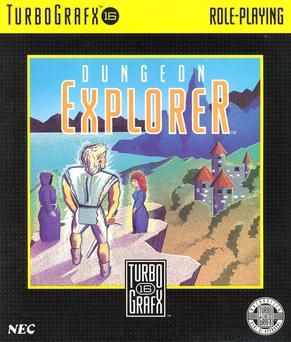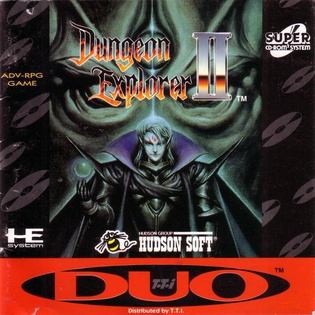
The PC-FX is a 32-bit home video game console developed by NEC and Hudson Soft. It was released in 1994 and discontinued in February 1998, as NEC's final home video game console. Based on the NEC V810 CPU and CD-ROM, it was intended as the successor to the PC Engine. Unlike its predecessor, the PC-FX was only released in Japan.

The TurboGrafx-16, known as the PC Engine outside North America, is a home video game console designed by Hudson Soft and sold by NEC Home Electronics. It was the first console marketed in the fourth generation, commonly known as the 16-bit era, though the console has an 8-bit central processing unit (CPU) coupled with a 16-bit graphics processor. It was released in Japan in 1987 and in North America in 1989. In Europe the Japanese model was unofficially imported and distributed in the United Kingdom and France from 1988. In Japan, the system was launched as a competitor to the Famicom, but the delayed United States release meant that it ended up competing with the Sega Genesis and later the Super NES.

The TurboExpress is an 8-bit handheld game console by NEC Home Electronics, released in late 1990 in Japan and the United States, branded as the PC Engine GT in Japan and TurboExpress Handheld Entertainment System in the U.S. It is essentially a portable version of the TurboGrafx-16 home console that came two to three years earlier. Its launch price in Japan was ¥44,800 and $249.99 in the U.S.

The TurboDuo is a fourth-generation video game console developed by NEC Home Electronics and Hudson Soft for the North American market. The TurboDuo was test-marketed in Los Angeles in October 1992, before a nationwide rollout in May 1993. It is the North American version of the Japanese PC Engine Duo game console which was released in September 1991.

Dungeon Explorer is an action role-playing video game developed by Atlus for the TurboGrafx-16 and originally published by Hudson Soft in Japan on March 4, 1989, and later in North America by NEC on November 15 of the same year. The first installment in the eponymous franchise, the game is set in the land of Oddesia, which has been overrun by an alien race and where players assume the role of one of eight main characters tasked with recovering the Ora stone to kill the alien king Natas. Co-directed by Kazutoshi Ueda and Yōsuke Niino, the title was created by most of the same team that would work on later several projects such as entries in the Megami Tensei series. Though it was initially launched for the TurboGrafx-16, it was later re-released through download services for various consoles.
VideoGames & Computer Entertainment was an American magazine dedicated to covering video games on computers, home consoles and arcades. It was published by LFP, Inc. from the late 1980s until the mid-1990s. Offering game reviews, previews, game strategies and cheat codes as well as coverage of the general industry, VG&CE was also one of the first magazines to cover both home console and computer games. The magazine gave out annual awards in a variety of categories, divided between the best of home video games and computer video games. The magazine featured original artwork by Alan Hunter and other freelance artists.

Alien Crush is a pinball video game developed by Compile for the PC Engine/TurboGrafx-16. It was released in 1988. The game is the first installment in the Crush Pinball series. It was followed by three sequels, Devil's Crush, Jaki Crush, and Alien Crush Returns. Alien Crush was later rereleased on the Virtual Console and on the PlayStation Network.

Neutopia II is a 1991 action-adventure/action role-playing video game developed and published in Japan by Hudson Soft and in North America by Turbo Technologies for the TurboGrafx-16. It is the sequel to Neutopia, which was released earlier in 1989. In the game, the player takes control of Jazeta's son, who embarks on a quest to both save his father and defeat the returning evil demon Dirth.

Valis III is a 1990 action-platform video game originally developed by Laser Soft, published by Telenet Japan and NEC for the TurboGrafx-CD. A Sega Genesis version was released in 1991. It is the third entry in the Valis series. It stars Yuko Asou, a Japanese teenage schoolgirl chosen as the Valis warrior and wielder of the mystical Valis sword after the events of Valis II. King Glames, wielder of the sword Leethus, leads denizens of the dark world to conquer both Vecanti and Earth, seeking refuge for his people amid the destruction of their planet. Together with the demon warrior-maiden Cham and her sister Valna, Yuko must prevent Glames from destroying both worlds. Through the journey, the player explores and searches for items and power-ups while fighting enemies and defeating bosses.

Gunhed, known as Blazing Lazers in North America, is a vertically scrolling shooter game by Hudson Soft and Compile, based on the Japanese film Gunhed. The title was released in 1989, for the PC Engine in Japan and re-skinned for the TurboGrafx-16 in North America, with Gunhed unofficially imported for the PC Engine in Europe. In the game, a fictional galaxy is under attack by an enemy space armada called the Dark Squadron, and this galaxy's only chance for survival is the Gunhed Advanced Star Fighter, who must destroy the Dark Squadron and its Super Weapons. The gameplay features fast vertical scrolling and a wide array of weapons for the player to use.

The Legendary Axe is a horizontal platform video game for the TurboGrafx-16. It was developed and published by Victor Musical Industries in Japan and by NEC in North America. It was released in Japan on September 23, 1988 and in North America as a TurboGrafx-16 launch title on August 29, 1989. In the game, the player controls Gogan, a barbarian whose girl, Flare, was kidnapped by the cult of Jagu. The player must navigate through six platforming levels, armed with a legendary axe named "Sting" to defeat Jagu and his minions and rescue Flare. The game features a rechargeable "strength meter" that determines how much damage is dealt from the axe to enemies.

Chew Man Fu is a 1990 action video game developed by Now Production and published in Japan by Hudson Soft and in North America by NEC for the TurboGrafx-16.

Drop Off is a Breakout clone by Data East. The game was published in 1990 for the PC Engine as Drop Rock Hora Hora and subsequently saw a US release for the TurboGrafx-16 as Drop Off.

Deep Blue is horizontally scrolling shooter for the TurboGrafx-16 published in 1989. The player controls a submersible fighter shaped as a freshwater angelfish that must fight through waves of mutated marine life.

Gate of Thunder is a 1992 scrolling shooter video game developed by Red Company and published by Hudson Soft for the TurboGrafx-CD. It was the first game released in North America to support the Super CD-ROM² format and served as one of the pack-in games for the TurboDuo, a two-in-one system which runs both TurboGrafx-CD and TurboGrafx-16 titles, where it was bundled with Bonk's Adventure, Bonk's Revenge and Bomberman on the same disc. In the game, the player controls the Hunting Dog space fighter craft, piloted by space cop Hawk. Alongside his ally Esty, piloting the Wild Cat support ship, Hawk must stop General Don Jingi and his Obellon armada from obtaining the powerful "Starlight" energy source from planet Aries.

Larry Flynt Publications, or LFP, Inc. is an American business enterprise that owns, manages and operates the adult entertainment businesses founded by American entrepreneur Larry Flynt. Founded in 1976, two years after Flynt began publishing Hustler magazine, LFP was originally established to serve as the legal business entity i.e. parent company of this magazine.
The TurboGrafx-16 Mini, also known as the PC Engine Mini in Japan and PC Engine CoreGrafx Mini in Europe, is a dedicated home video game console by Konami modeled on NEC's TurboGrafx-16, which was designed by Hudson Soft, a video game developer which Konami acquired in 2012. The Mini emulates the original console's 8-bit hardware. The Japanese model contains 58 games in total while the international models contain 57. The Mini was originally set to be released worldwide on March 19, 2020, exclusively through Amazon, but was delayed everywhere except for Japan because of the COVID-19 pandemic. It was shipped in North America on May 22, 2020, and in Europe on June 5, 2020.

Dungeon Explorer II is an action role-playing video game developed and originally published by Hudson Soft for the TurboDuo in Japan on March 26, 1993, and in North America by Turbo Technologies in October of the same year. A sequel to 1989's Dungeon Explorer, it is the second installment in the eponymous franchise.

King of Casino is a 1990 gambling simulation video game developed by Algorithm Institute, published in Japan by Victor Musical Industries and in North America by NEC for the TurboGrafx-16. The game sees the players go to different casinos with $10000, using the money to participate in poker, blackjack, roulette, slot machines and keno, in order to win $10 million. After selecting one of the three playing modes, there are 15 casinos with slight differences to choose on a town map. Inside the casino the games itself are started by clicking on one of the gambling tables. It received generally favourable reception from critics, most of which reviewed it as an import title.

















